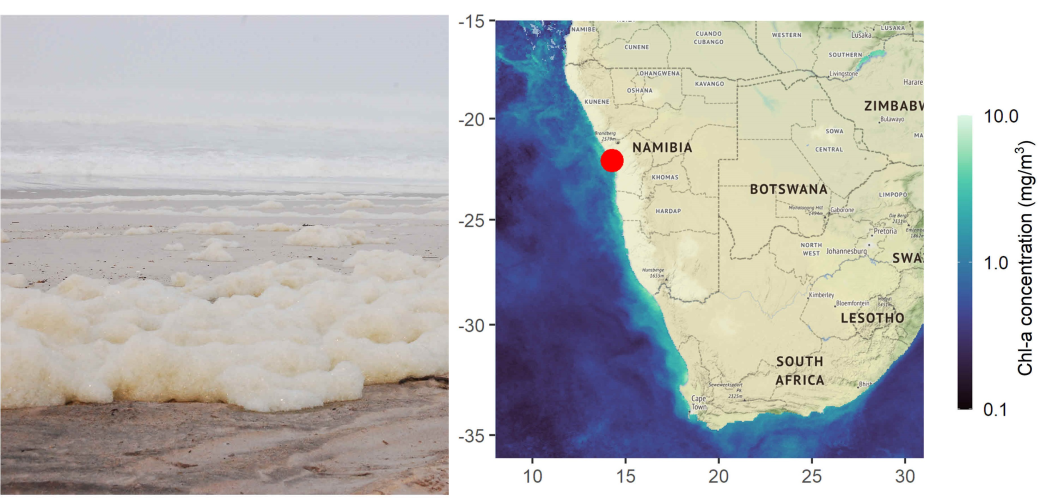
Lead supervisor: Chiara Giorio, Chemistry
Co-supervisor: Alexander Zherebker, Chemistry
Brief summary:
This project will assess the role of marine biogenic emissions in new particle formation and growth observed on a coastal site in Namibia.
Importance of the area of research concerned:
Marine ecosystems are important drivers of the global climate system. They emit volatile species into the atmosphere, involved in complex reaction cycles that influence the lifetime of greenhouse gases. They also emit sea spray and marine biogenic aerosols that affect the Earth's climate by scattering solar radiation and controlling cloud microphysical properties. A notable example is dimethyl sulfide (DMS), emitted by the marine biota; it is an efficient aerosol and cloud droplet producer. According to the CLAW hypothesis [1], DMS emissions are key in the establishment of a feedback loop between global warming, enhanced production of marine plankton, and increased emissions of DMS leading to production of aerosol particles that would cause cooling. The Benguela upwelling system, off the west coast of southern Africa, is a well-known ecosystem in which upwelling pulses of nutrient-rich waters induce high biological production. As a consequence of upwelling along the north coast of Namibia, phytoplankton blooms are frequent, leading to strong emissions of DMS and volatile organic compounds (VOCs) [2].
Project summary :
A recent study on the coast of Namibia [3] pointed out a strong marine biogenic source of butenes, which were previously thought to be anthropogenic compounds. Such emissions were orders of magnitude higher than DMS emissions. When strong emissions of butenes were observed, new particle formation (NPF) events followed shortly after. While the atmospheric fate of DMS is studied extensively, less is known about how butenes contribute to new particle formation and growth. The aims of this project are (1) to assess what the role of butene emissions is on new particle formation and growth and how marine VOC emissions can contribute to aerosol aging, including mineral dusts being transported from the Namib desert, (2) to determine the optical and hygroscopic properties of newly formed and aged particles.
What will the student do?:
The student will be based at the Department of Chemistry, where the supervisory team will assist the student in familiarising with aerosol sampling techniques, liquid chromatography high-resolution mass spectrometry (LC-HRMS), and solution and solid-state NMR for the molecular and structural characterisation of organic and organometallic compounds in aerosols. The student will run a wide range chemical characterisation of aerosol samples with particles of different sizes and become proficient with the data analysis of both high-resolution mass spectrometry and NMR. The student will also have the opportunity of contributing to the data analysis of field deployed instruments, such as those for the measurements of the optical properties of aerosol particles and their ability to act as cloud condensation nuclei. The student will have a chance to interact with an international network of collaborations, work in a diverse and international team, and to present the results at international conferences.
References - references should provide further reading about the project:
Andreae, M. O., Elbert, W., & deMora, S. J. (1995). Biogenic sulfur emissions and aerosols over the tropical South Atlantic: 3. Atmospheric dimethylsulfide, aerosols and cloud condensation nuclei. Journal of Geophysical Research, 100(D6), 11335. https://doi.org/10.1029/94JD02828
Lamont, T., Barlow, R. G., & Brewin, R. J. W. (2019). Long-Term Trends in Phytoplankton Chlorophyll a and Size Structure in the Benguela Upwelling System. Journal of Geophysical Research: Oceans, 124(2), 1170–1195. https://doi.org/10.1029/2018JC014334
Giorio, C., Doussin, J.-F., D’Anna, B., Mas, S., Filippi, D., Denjean, C., et al. (2022). Butene emissions from coastal ecosystems may contribute to new particle formation. Geophysical Research Letters, 49, e2022GL098770. https://doi. org/10.1029/2022GL098770
Applying
You can find out about applying for this project on the Department of Chemistry page.